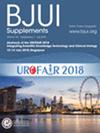Renal, bladder and prostate cancer surgery outcomes with respect to team familiarity.
IF 4.4
2区 医学
Q1 UROLOGY & NEPHROLOGY
引用次数: 0
Abstract
OBJECTIVES To investigate outcomes in urological oncology according to team membership and familiarity. SUBJECTS/PATIENTS We assessed peri-operative times, lengths of stay and re-admission rates in all patients undergoing surgery for prostate, bladder and kidney cancer at Sheffield Teaching Hospitals from 2021 to September 2024. Our analysis was performed with respect to staff pairs and a validated familiarity score (FS) derived using seven team members. RESULTS In total, 1043 patients, 319 staff members and 3791 staff combinations were included. The mean (sd) FS for all cases was 14.2 (7.2), and was 13.7 (7.3), 9.3 (4.1) and 16.7 (7.1) for renal, bladder and prostate surgeries (anova, P < 0.001), respectively. Teams with higher familiarity had shorter times for all peri-operative intervals (anova, P < 0.041), shorter lengths of stay (1.94 vs 5.3 days; anova, P < 0.001) and fewer readmissions within 30 days (4.1% vs 8.0%; chi-squared test, P = 0.01). Greater familiarity led to savings of 26.2, 44.2 and 12.8 min for renal, bladder and prostate surgeries, respectively. In multiple regression, using preoperative features, greater familiarity was associated with fewer total case min (each 1-unit increase in FS equated to -1.88 min; 95% confidence interval -2.25 to -1.29; P < 0.001). Regarding team dyads, the greatest difference in total case duration was for the Surgeon #1/Surgeon #2 combination (average 40.8-min saving). Increased anaesthetic familiarity (with anaesthetic assistant) was associated with shorter anaesthetic room durations (anova, P = 0.007) and shorter delays leaving theatre (P < 0.001). CONCLUSION Greater team familiarity was associated with faster surgical times and shorter lengths of stay. The time savings could be used to improve theatre usage and efficiency.肾癌、膀胱癌和前列腺癌手术结果与团队熟悉度的关系。
目的根据团队成员和熟悉程度调查泌尿外科肿瘤的预后。研究对象/患者我们评估了2021年至2024年9月在谢菲尔德教学医院接受前列腺癌、膀胱癌和肾癌手术的所有患者的围手术期时间、住院时间和再入院率。我们的分析是针对员工对进行的,并使用7名团队成员得出了经过验证的熟悉度评分(FS)。结果共纳入1043例患者,319名工作人员,3791组工作人员。所有病例的平均(sd) FS为14.2(7.2),肾、膀胱和前列腺手术分别为13.7(7.3)、9.3(4.1)和16.7(7.1)(方差分析,P < 0.001)。熟悉度较高的小组在所有围手术期的时间较短(方差分析,P < 0.041),住院时间较短(1.94对5.3天;方差分析,P < 0.001), 30天内再入院率较低(4.1%对8.0%;卡方检验,P = 0.01)。熟悉程度的提高分别为肾脏、膀胱和前列腺手术节省了26.2分钟、44.2分钟和12.8分钟。在使用术前特征的多元回归中,熟悉度越高,总病例分钟越少(FS每增加1个单位等于-1.88分钟;95%置信区间为-2.25至-1.29;P < 0.001)。对于团队二人组,总病例持续时间的最大差异是外科医生1/外科医生2组合(平均节省40.8分钟)。增加麻醉熟悉度(与麻醉助手)与更短的麻醉室持续时间(方差分析,P = 0.007)和更短的离开手术室延误(P < 0.001)相关。结论对团队熟悉程度越高,手术时间越短,住院时间越短。节省下来的时间可以用来提高剧院的使用率和效率。
本文章由计算机程序翻译,如有差异,请以英文原文为准。
求助全文
约1分钟内获得全文
求助全文
来源期刊

BJU International
医学-泌尿学与肾脏学
CiteScore
9.10
自引率
4.40%
发文量
262
审稿时长
1 months
期刊介绍:
BJUI is one of the most highly respected medical journals in the world, with a truly international range of published papers and appeal. Every issue gives invaluable practical information in the form of original articles, reviews, comments, surgical education articles, and translational science articles in the field of urology. BJUI employs topical sections, and is in full colour, making it easier to browse or search for something specific.
 求助内容:
求助内容: 应助结果提醒方式:
应助结果提醒方式:


